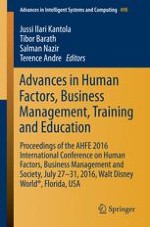2017 | OriginalPaper | Buchkapitel
Scale and Spatial Resolution Guidelines for the Design of Virtual Engineering Laboratories
verfasst von : Brian Sanders, Dennis Vincenzi, Yuzhong Shen
Erschienen in: Advances in Human Factors, Business Management, Training and Education
Aktivieren Sie unsere intelligente Suche, um passende Fachinhalte oder Patente zu finden.
Wählen Sie Textabschnitte aus um mit Künstlicher Intelligenz passenden Patente zu finden. powered by
Markieren Sie Textabschnitte, um KI-gestützt weitere passende Inhalte zu finden. powered by
